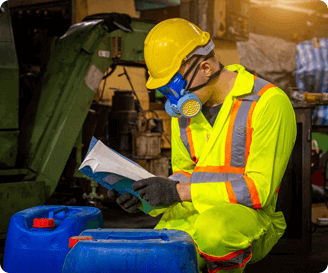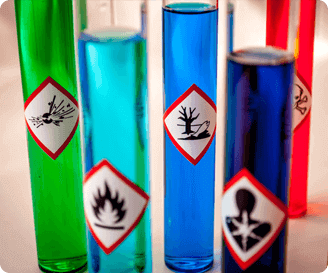
What is HAZCOM? A Safety Manager’s Guide
Ever looked at a chemical drum with a faded label and thought, Is this even safe to touch? That’s where hazard communication—or HAZCOM—comes in.
It’s not just about ticking off a compliance box. It’s about making sure every worker knows what they’re handling, how to handle it safely, and what to do if things go wrong.
In this guide, we’ll break down what HAZCOM really means, what goes into a solid program, and how you can avoid the slip-ups that often get overlooked.
What is HAZCOM?
HAZCOM stands for Hazard Communication, and it’s a regulation set by OSHA to make sure workers know exactly what chemical hazards they’re exposed to at work. Sounds simple, right? But in practice, it’s often where confusion and compliance gaps creep in.

At its heart, HAZCOM is about transparency. Every chemical in the workplace—from heavy solvents to basic cleaning agents—comes with risks. The HAZCOM standard makes sure those risks aren’t hidden in fine print or behind locked doors. It’s built on the “right-to-know” principle: employees have a right to know what they’re working with and how to stay safe around it.
The regulation is formally known as 29 CFR 1910.1200, and while it may read like legalese, its intent is pretty clear:
Make chemical safety information accessible, understandable, and consistent across all workplaces.
Whether you’re running a construction site, manufacturing plant, or small lab, if chemicals are part of the job, HAZCOM applies.
The 5 Key Elements of a HAZCOM Program
A compliant HAZCOM program isn’t one-size-fits-all, but OSHA expects these five core pieces to be in place:
1. Chemical Inventory
Start here. You need a full list of every hazardous chemical in your facility. That includes cleaning agents, adhesives, paints, and anything else with a warning label. It’s easy to miss something unless you do a thorough walkthrough.
2. Safety Data Sheets (SDS)

Every chemical on your list must have a corresponding SDS. These sheets contain everything from hazard classifications to first-aid measures. Workers must be able to access them easily—no locked file cabinets or dusty folders in HR.
Tip: Make sure SDSs are updated. Outdated or missing sheets are one of the most common violations during inspections.
3. Labels and Warnings
All chemical containers—whether they’re original packaging or secondary containers—need proper labels. Thanks to the GHS (more on that in a bit), labels now follow a standardized format with pictograms, signal words, and hazard statements.
No scribbled notes or color-coded dots. Real labels, every time.
4. Written HAZCOM Program
Yes, it needs to be on paper (or digital, if that works for your team). The written program should describe how your facility meets HAZCOM requirements: how you label chemicals, where SDSs are kept, how you train employees, and how new hazards are communicated.
Keep it updated. If your processes or chemicals change, the plan should too.
5. Employee Information
Employees need to know where to find SDSs, how to read labels, and what actions to take in case of exposure. This isn’t a one-and-done task. Build it into onboarding and refresh it regularly.
What is GHS and How It Relates to HAZCOM
The Globally Harmonized System (GHS) is a worldwide framework for classifying and labeling chemicals. OSHA adopted GHS into the HAZCOM standard back in 2012 to make things more consistent—and honestly, more readable.
Thanks to GHS, you’ll now see standard pictograms on labels (like the flame or skull-and-crossbones), signal words like “Danger” or “Warning,” and standardized sections in every SDS. It makes training easier and helps reduce misunderstandings, especially in multilingual workplaces.
If your labels still look like they were made in the ‘90s, it might be time for a refresh.
Common HAZCOM Compliance Mistakes to Avoid
Even experienced teams slip up. Here are a few missteps we see more often than you’d think:
- Missing SDSs – Often for common items like cleaning sprays or lubricants
- Improper labels – Secondary containers without clear labels are a big red flag
- One-time training – Safety training needs to be ongoing, especially when new chemicals are introduced
- Unreadable or faded labels – Time and sunlight can erase important info
- No written program – Or worse, one that’s collecting dust and hasn’t been updated in years
A quick internal audit every quarter can save you from a costly OSHA citation.
Steps to Build or Improve Your HAZCOM Program
If you’re starting from scratch—or trying to get things back on track—here’s a simple roadmap:

1. Create a full chemical inventory
2. Collect and organize SDSs for each item
3. Label all containers using GHS standards
4. Write (or update) your HAZCOM plan
5. Make SDSs accessible—physically or digitally
6. Educate your team regularly, not just during onboarding
7. Review your program every 6–12 months or when major changes happen
Digital Tools Can Help
Let’s be honest: managing all this manually is tough. Especially in larger facilities.
There are safety management platforms that can help automate SDS access, manage chemical inventories, and alert you when something’s missing. It’s not mandatory, but it sure makes life easier—especially during audits.
Even a basic spreadsheet + cloud storage system is better than paper binders buried in a filing cabinet.
Final Thoughts
HAZCOM isn’t just about compliance—it’s about care. When workers know exactly what they’re dealing with, they’re more confident, more cautious, and more prepared.
It might not be the flashiest part of your safety program, but it’s one of the most essential. Keep it clear. Keep it current. And if in doubt? Label it.
This article was generated with the assistance of AI and reviewed by Ben Johnson for accuracy and quality.
Ben Johnson is a dedicated Customer Success Executive at Safetymint. With a strong commitment to excellence, Ben works closely with customers to ensure they fully leverage the capabilities of Safetymint to its fullest potential, aiming to significantly reduce or mitigate safety risks and incidents.



